Literature Review Assignment 2022
VerifiedAdded on 2022/10/11
|10
|2769
|16
Assignment
AI Summary
Contribute Materials
Your contribution can guide someone’s learning journey. Share your
documents today.
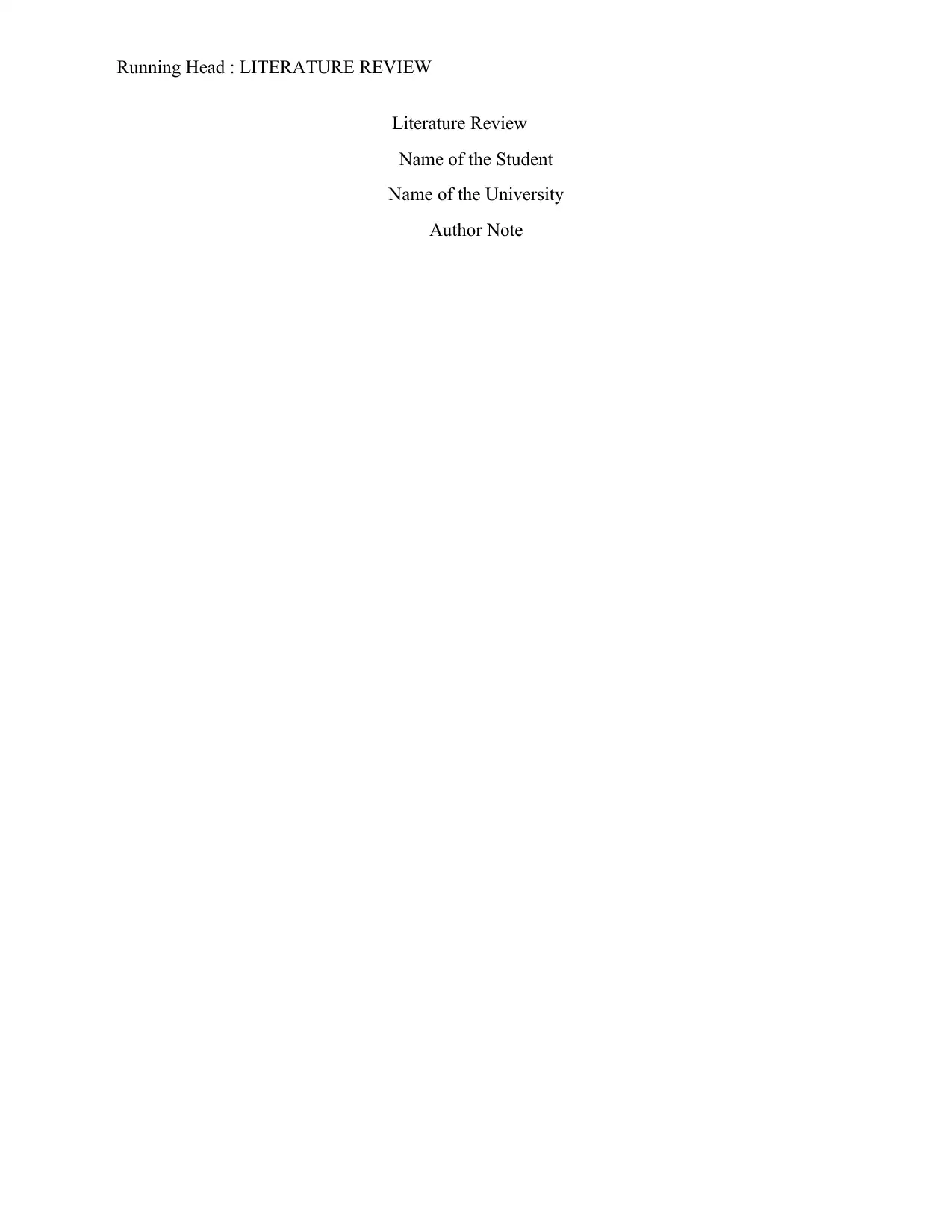
Running Head : LITERATURE REVIEW
Literature Review
Name of the Student
Name of the University
Author Note
Literature Review
Name of the Student
Name of the University
Author Note
Secure Best Marks with AI Grader
Need help grading? Try our AI Grader for instant feedback on your assignments.
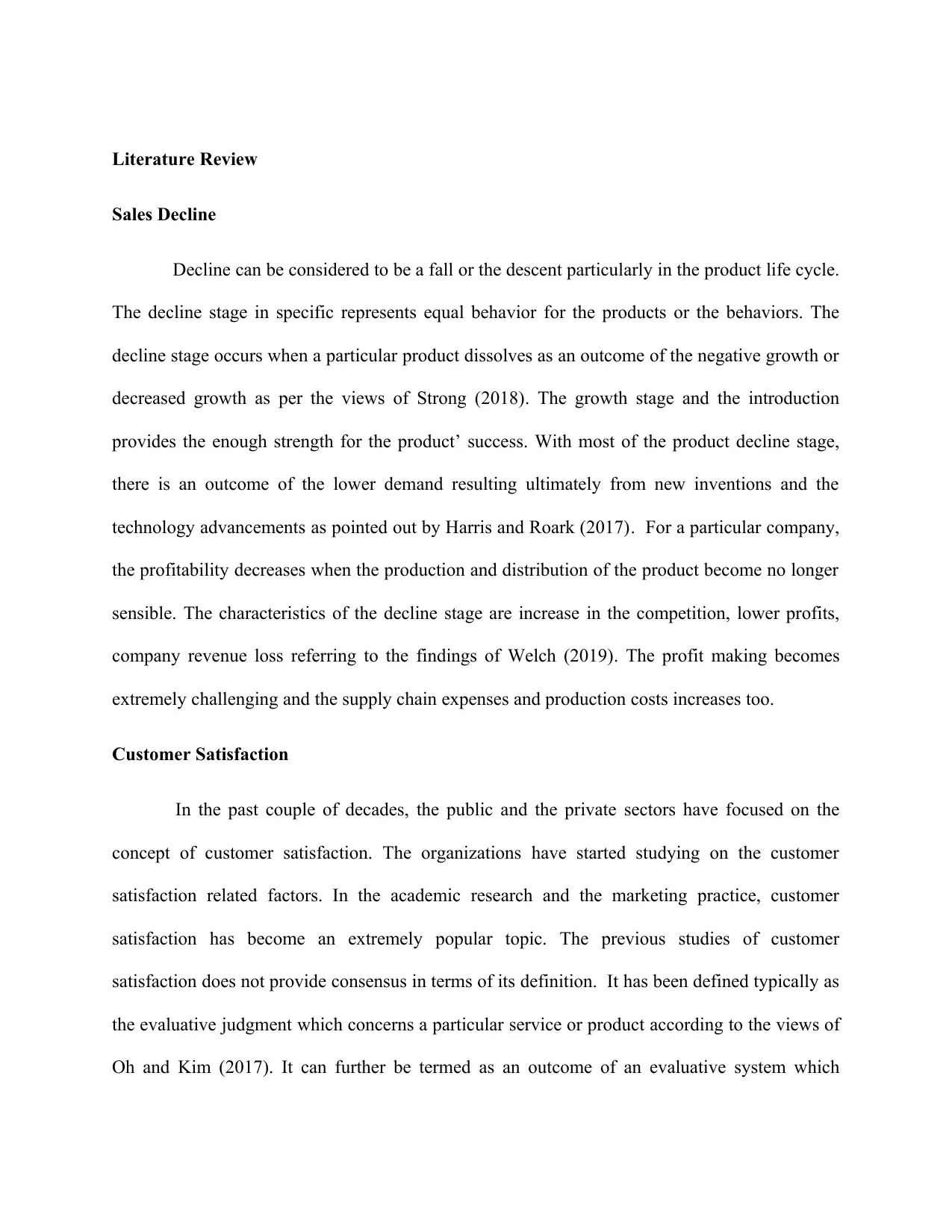
Literature Review
Sales Decline
Decline can be considered to be a fall or the descent particularly in the product life cycle.
The decline stage in specific represents equal behavior for the products or the behaviors. The
decline stage occurs when a particular product dissolves as an outcome of the negative growth or
decreased growth as per the views of Strong (2018). The growth stage and the introduction
provides the enough strength for the product’ success. With most of the product decline stage,
there is an outcome of the lower demand resulting ultimately from new inventions and the
technology advancements as pointed out by Harris and Roark (2017). For a particular company,
the profitability decreases when the production and distribution of the product become no longer
sensible. The characteristics of the decline stage are increase in the competition, lower profits,
company revenue loss referring to the findings of Welch (2019). The profit making becomes
extremely challenging and the supply chain expenses and production costs increases too.
Customer Satisfaction
In the past couple of decades, the public and the private sectors have focused on the
concept of customer satisfaction. The organizations have started studying on the customer
satisfaction related factors. In the academic research and the marketing practice, customer
satisfaction has become an extremely popular topic. The previous studies of customer
satisfaction does not provide consensus in terms of its definition. It has been defined typically as
the evaluative judgment which concerns a particular service or product according to the views of
Oh and Kim (2017). It can further be termed as an outcome of an evaluative system which
Sales Decline
Decline can be considered to be a fall or the descent particularly in the product life cycle.
The decline stage in specific represents equal behavior for the products or the behaviors. The
decline stage occurs when a particular product dissolves as an outcome of the negative growth or
decreased growth as per the views of Strong (2018). The growth stage and the introduction
provides the enough strength for the product’ success. With most of the product decline stage,
there is an outcome of the lower demand resulting ultimately from new inventions and the
technology advancements as pointed out by Harris and Roark (2017). For a particular company,
the profitability decreases when the production and distribution of the product become no longer
sensible. The characteristics of the decline stage are increase in the competition, lower profits,
company revenue loss referring to the findings of Welch (2019). The profit making becomes
extremely challenging and the supply chain expenses and production costs increases too.
Customer Satisfaction
In the past couple of decades, the public and the private sectors have focused on the
concept of customer satisfaction. The organizations have started studying on the customer
satisfaction related factors. In the academic research and the marketing practice, customer
satisfaction has become an extremely popular topic. The previous studies of customer
satisfaction does not provide consensus in terms of its definition. It has been defined typically as
the evaluative judgment which concerns a particular service or product according to the views of
Oh and Kim (2017). It can further be termed as an outcome of an evaluative system which
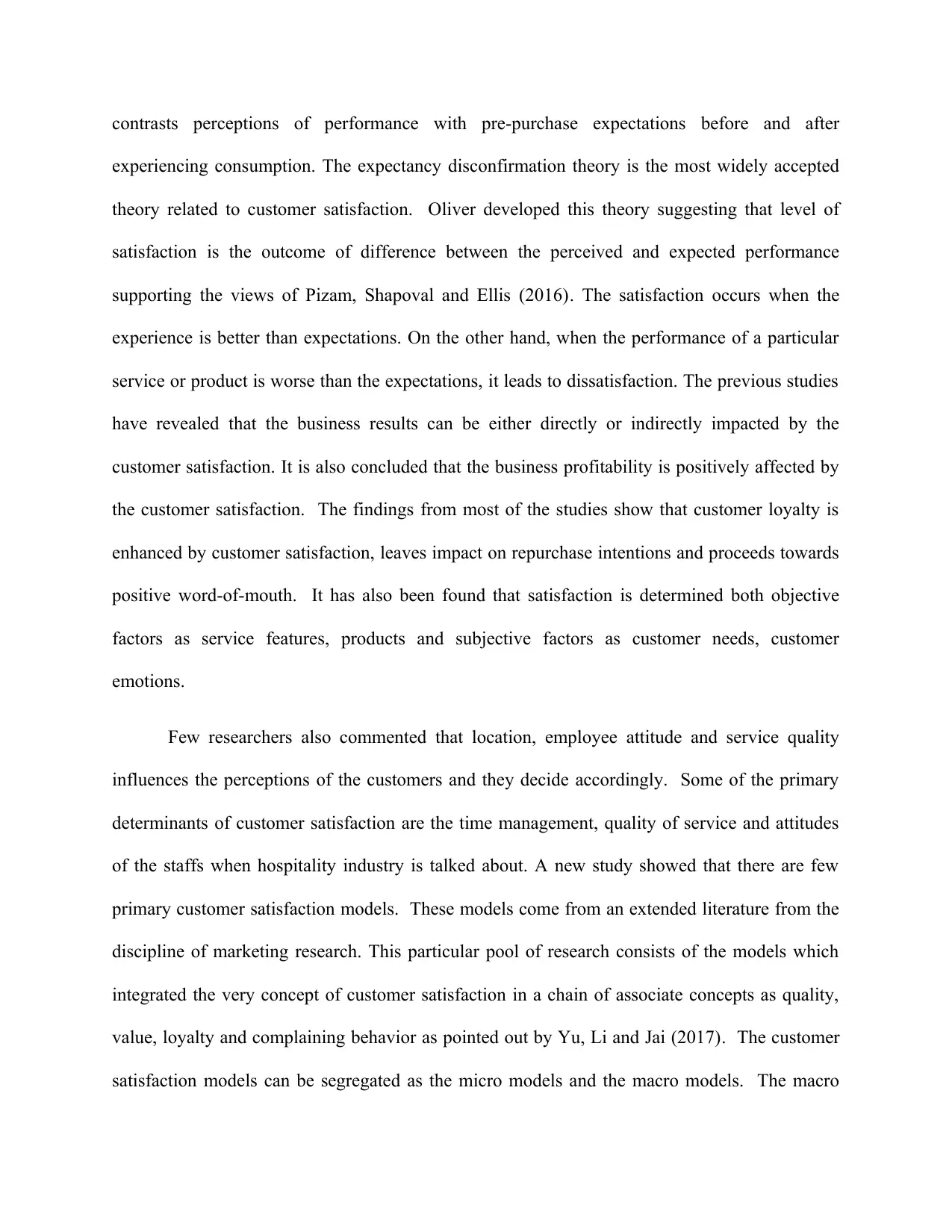
contrasts perceptions of performance with pre-purchase expectations before and after
experiencing consumption. The expectancy disconfirmation theory is the most widely accepted
theory related to customer satisfaction. Oliver developed this theory suggesting that level of
satisfaction is the outcome of difference between the perceived and expected performance
supporting the views of Pizam, Shapoval and Ellis (2016). The satisfaction occurs when the
experience is better than expectations. On the other hand, when the performance of a particular
service or product is worse than the expectations, it leads to dissatisfaction. The previous studies
have revealed that the business results can be either directly or indirectly impacted by the
customer satisfaction. It is also concluded that the business profitability is positively affected by
the customer satisfaction. The findings from most of the studies show that customer loyalty is
enhanced by customer satisfaction, leaves impact on repurchase intentions and proceeds towards
positive word-of-mouth. It has also been found that satisfaction is determined both objective
factors as service features, products and subjective factors as customer needs, customer
emotions.
Few researchers also commented that location, employee attitude and service quality
influences the perceptions of the customers and they decide accordingly. Some of the primary
determinants of customer satisfaction are the time management, quality of service and attitudes
of the staffs when hospitality industry is talked about. A new study showed that there are few
primary customer satisfaction models. These models come from an extended literature from the
discipline of marketing research. This particular pool of research consists of the models which
integrated the very concept of customer satisfaction in a chain of associate concepts as quality,
value, loyalty and complaining behavior as pointed out by Yu, Li and Jai (2017). The customer
satisfaction models can be segregated as the micro models and the macro models. The macro
experiencing consumption. The expectancy disconfirmation theory is the most widely accepted
theory related to customer satisfaction. Oliver developed this theory suggesting that level of
satisfaction is the outcome of difference between the perceived and expected performance
supporting the views of Pizam, Shapoval and Ellis (2016). The satisfaction occurs when the
experience is better than expectations. On the other hand, when the performance of a particular
service or product is worse than the expectations, it leads to dissatisfaction. The previous studies
have revealed that the business results can be either directly or indirectly impacted by the
customer satisfaction. It is also concluded that the business profitability is positively affected by
the customer satisfaction. The findings from most of the studies show that customer loyalty is
enhanced by customer satisfaction, leaves impact on repurchase intentions and proceeds towards
positive word-of-mouth. It has also been found that satisfaction is determined both objective
factors as service features, products and subjective factors as customer needs, customer
emotions.
Few researchers also commented that location, employee attitude and service quality
influences the perceptions of the customers and they decide accordingly. Some of the primary
determinants of customer satisfaction are the time management, quality of service and attitudes
of the staffs when hospitality industry is talked about. A new study showed that there are few
primary customer satisfaction models. These models come from an extended literature from the
discipline of marketing research. This particular pool of research consists of the models which
integrated the very concept of customer satisfaction in a chain of associate concepts as quality,
value, loyalty and complaining behavior as pointed out by Yu, Li and Jai (2017). The customer
satisfaction models can be segregated as the micro models and the macro models. The macro
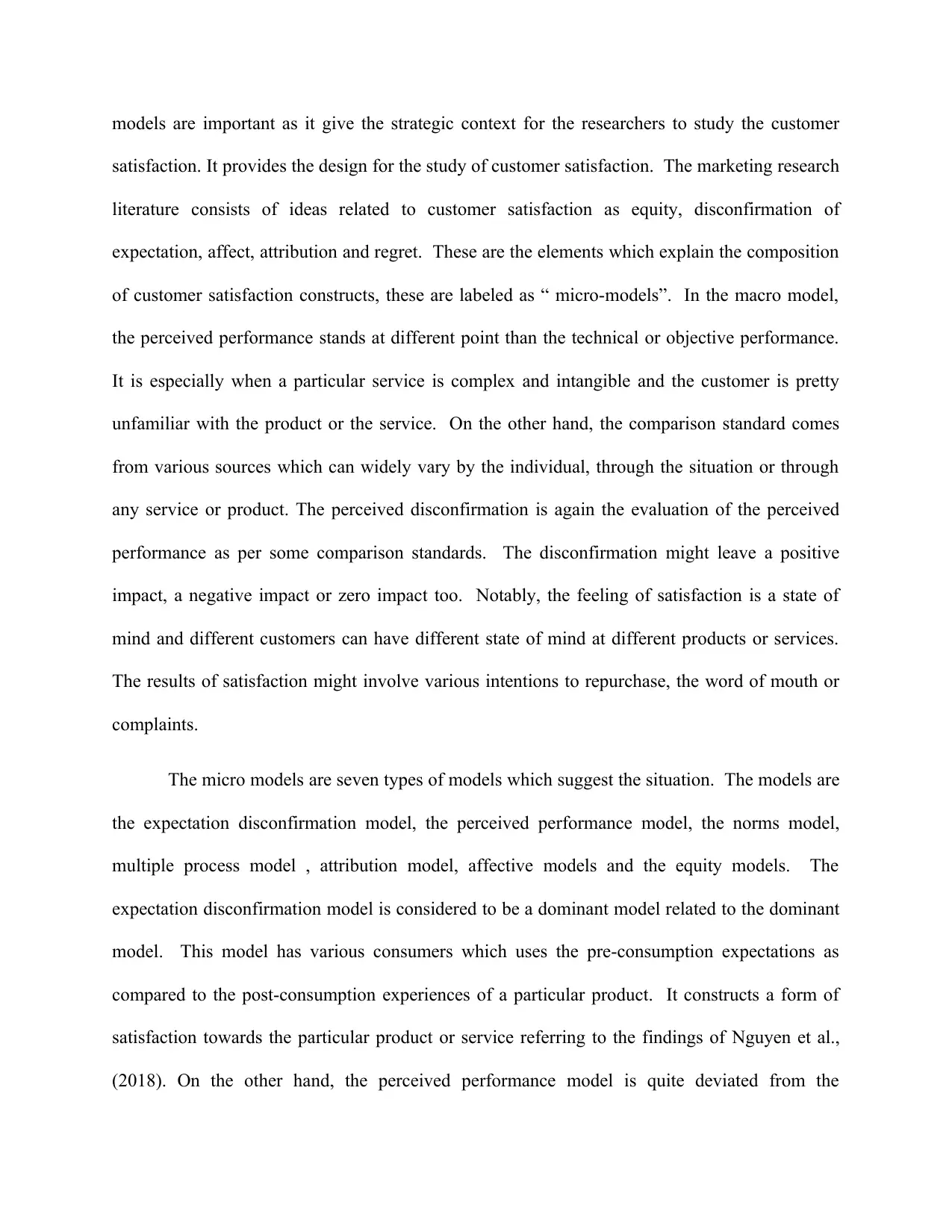
models are important as it give the strategic context for the researchers to study the customer
satisfaction. It provides the design for the study of customer satisfaction. The marketing research
literature consists of ideas related to customer satisfaction as equity, disconfirmation of
expectation, affect, attribution and regret. These are the elements which explain the composition
of customer satisfaction constructs, these are labeled as “ micro-models”. In the macro model,
the perceived performance stands at different point than the technical or objective performance.
It is especially when a particular service is complex and intangible and the customer is pretty
unfamiliar with the product or the service. On the other hand, the comparison standard comes
from various sources which can widely vary by the individual, through the situation or through
any service or product. The perceived disconfirmation is again the evaluation of the perceived
performance as per some comparison standards. The disconfirmation might leave a positive
impact, a negative impact or zero impact too. Notably, the feeling of satisfaction is a state of
mind and different customers can have different state of mind at different products or services.
The results of satisfaction might involve various intentions to repurchase, the word of mouth or
complaints.
The micro models are seven types of models which suggest the situation. The models are
the expectation disconfirmation model, the perceived performance model, the norms model,
multiple process model , attribution model, affective models and the equity models. The
expectation disconfirmation model is considered to be a dominant model related to the dominant
model. This model has various consumers which uses the pre-consumption expectations as
compared to the post-consumption experiences of a particular product. It constructs a form of
satisfaction towards the particular product or service referring to the findings of Nguyen et al.,
(2018). On the other hand, the perceived performance model is quite deviated from the
satisfaction. It provides the design for the study of customer satisfaction. The marketing research
literature consists of ideas related to customer satisfaction as equity, disconfirmation of
expectation, affect, attribution and regret. These are the elements which explain the composition
of customer satisfaction constructs, these are labeled as “ micro-models”. In the macro model,
the perceived performance stands at different point than the technical or objective performance.
It is especially when a particular service is complex and intangible and the customer is pretty
unfamiliar with the product or the service. On the other hand, the comparison standard comes
from various sources which can widely vary by the individual, through the situation or through
any service or product. The perceived disconfirmation is again the evaluation of the perceived
performance as per some comparison standards. The disconfirmation might leave a positive
impact, a negative impact or zero impact too. Notably, the feeling of satisfaction is a state of
mind and different customers can have different state of mind at different products or services.
The results of satisfaction might involve various intentions to repurchase, the word of mouth or
complaints.
The micro models are seven types of models which suggest the situation. The models are
the expectation disconfirmation model, the perceived performance model, the norms model,
multiple process model , attribution model, affective models and the equity models. The
expectation disconfirmation model is considered to be a dominant model related to the dominant
model. This model has various consumers which uses the pre-consumption expectations as
compared to the post-consumption experiences of a particular product. It constructs a form of
satisfaction towards the particular product or service referring to the findings of Nguyen et al.,
(2018). On the other hand, the perceived performance model is quite deviated from the
Secure Best Marks with AI Grader
Need help grading? Try our AI Grader for instant feedback on your assignments.
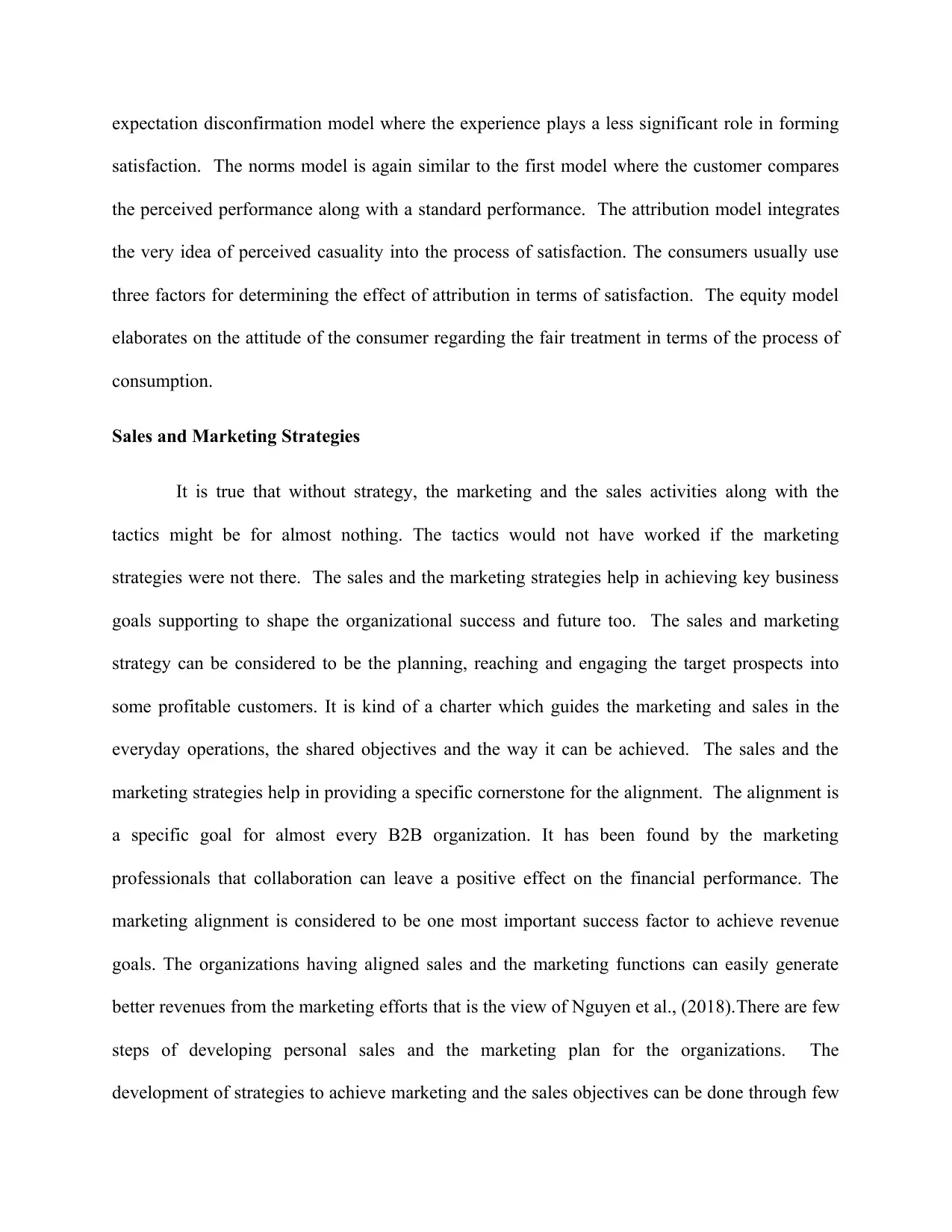
expectation disconfirmation model where the experience plays a less significant role in forming
satisfaction. The norms model is again similar to the first model where the customer compares
the perceived performance along with a standard performance. The attribution model integrates
the very idea of perceived casuality into the process of satisfaction. The consumers usually use
three factors for determining the effect of attribution in terms of satisfaction. The equity model
elaborates on the attitude of the consumer regarding the fair treatment in terms of the process of
consumption.
Sales and Marketing Strategies
It is true that without strategy, the marketing and the sales activities along with the
tactics might be for almost nothing. The tactics would not have worked if the marketing
strategies were not there. The sales and the marketing strategies help in achieving key business
goals supporting to shape the organizational success and future too. The sales and marketing
strategy can be considered to be the planning, reaching and engaging the target prospects into
some profitable customers. It is kind of a charter which guides the marketing and sales in the
everyday operations, the shared objectives and the way it can be achieved. The sales and the
marketing strategies help in providing a specific cornerstone for the alignment. The alignment is
a specific goal for almost every B2B organization. It has been found by the marketing
professionals that collaboration can leave a positive effect on the financial performance. The
marketing alignment is considered to be one most important success factor to achieve revenue
goals. The organizations having aligned sales and the marketing functions can easily generate
better revenues from the marketing efforts that is the view of Nguyen et al., (2018).There are few
steps of developing personal sales and the marketing plan for the organizations. The
development of strategies to achieve marketing and the sales objectives can be done through few
satisfaction. The norms model is again similar to the first model where the customer compares
the perceived performance along with a standard performance. The attribution model integrates
the very idea of perceived casuality into the process of satisfaction. The consumers usually use
three factors for determining the effect of attribution in terms of satisfaction. The equity model
elaborates on the attitude of the consumer regarding the fair treatment in terms of the process of
consumption.
Sales and Marketing Strategies
It is true that without strategy, the marketing and the sales activities along with the
tactics might be for almost nothing. The tactics would not have worked if the marketing
strategies were not there. The sales and the marketing strategies help in achieving key business
goals supporting to shape the organizational success and future too. The sales and marketing
strategy can be considered to be the planning, reaching and engaging the target prospects into
some profitable customers. It is kind of a charter which guides the marketing and sales in the
everyday operations, the shared objectives and the way it can be achieved. The sales and the
marketing strategies help in providing a specific cornerstone for the alignment. The alignment is
a specific goal for almost every B2B organization. It has been found by the marketing
professionals that collaboration can leave a positive effect on the financial performance. The
marketing alignment is considered to be one most important success factor to achieve revenue
goals. The organizations having aligned sales and the marketing functions can easily generate
better revenues from the marketing efforts that is the view of Nguyen et al., (2018).There are few
steps of developing personal sales and the marketing plan for the organizations. The
development of strategies to achieve marketing and the sales objectives can be done through few
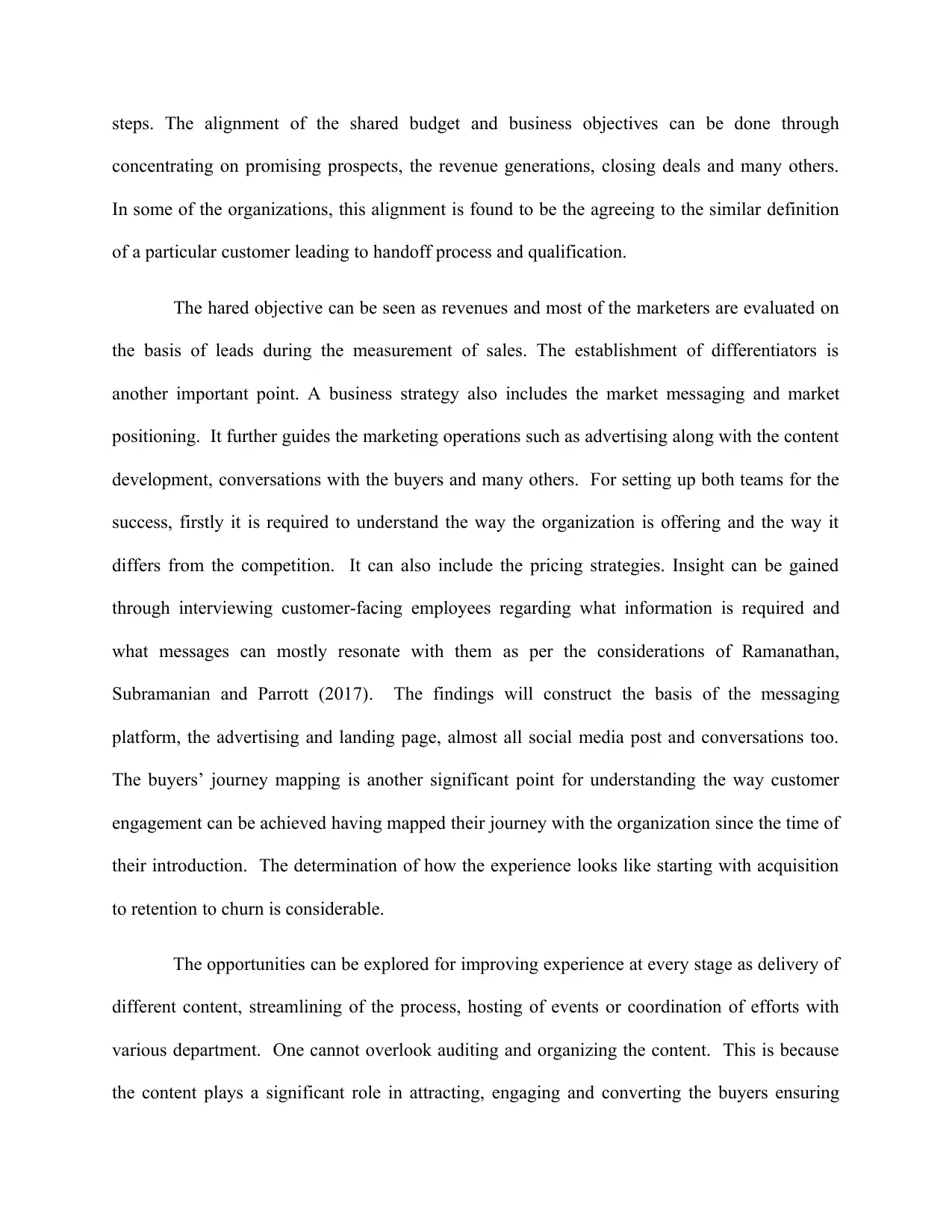
steps. The alignment of the shared budget and business objectives can be done through
concentrating on promising prospects, the revenue generations, closing deals and many others.
In some of the organizations, this alignment is found to be the agreeing to the similar definition
of a particular customer leading to handoff process and qualification.
The hared objective can be seen as revenues and most of the marketers are evaluated on
the basis of leads during the measurement of sales. The establishment of differentiators is
another important point. A business strategy also includes the market messaging and market
positioning. It further guides the marketing operations such as advertising along with the content
development, conversations with the buyers and many others. For setting up both teams for the
success, firstly it is required to understand the way the organization is offering and the way it
differs from the competition. It can also include the pricing strategies. Insight can be gained
through interviewing customer-facing employees regarding what information is required and
what messages can mostly resonate with them as per the considerations of Ramanathan,
Subramanian and Parrott (2017). The findings will construct the basis of the messaging
platform, the advertising and landing page, almost all social media post and conversations too.
The buyers’ journey mapping is another significant point for understanding the way customer
engagement can be achieved having mapped their journey with the organization since the time of
their introduction. The determination of how the experience looks like starting with acquisition
to retention to churn is considerable.
The opportunities can be explored for improving experience at every stage as delivery of
different content, streamlining of the process, hosting of events or coordination of efforts with
various department. One cannot overlook auditing and organizing the content. This is because
the content plays a significant role in attracting, engaging and converting the buyers ensuring
concentrating on promising prospects, the revenue generations, closing deals and many others.
In some of the organizations, this alignment is found to be the agreeing to the similar definition
of a particular customer leading to handoff process and qualification.
The hared objective can be seen as revenues and most of the marketers are evaluated on
the basis of leads during the measurement of sales. The establishment of differentiators is
another important point. A business strategy also includes the market messaging and market
positioning. It further guides the marketing operations such as advertising along with the content
development, conversations with the buyers and many others. For setting up both teams for the
success, firstly it is required to understand the way the organization is offering and the way it
differs from the competition. It can also include the pricing strategies. Insight can be gained
through interviewing customer-facing employees regarding what information is required and
what messages can mostly resonate with them as per the considerations of Ramanathan,
Subramanian and Parrott (2017). The findings will construct the basis of the messaging
platform, the advertising and landing page, almost all social media post and conversations too.
The buyers’ journey mapping is another significant point for understanding the way customer
engagement can be achieved having mapped their journey with the organization since the time of
their introduction. The determination of how the experience looks like starting with acquisition
to retention to churn is considerable.
The opportunities can be explored for improving experience at every stage as delivery of
different content, streamlining of the process, hosting of events or coordination of efforts with
various department. One cannot overlook auditing and organizing the content. This is because
the content plays a significant role in attracting, engaging and converting the buyers ensuring
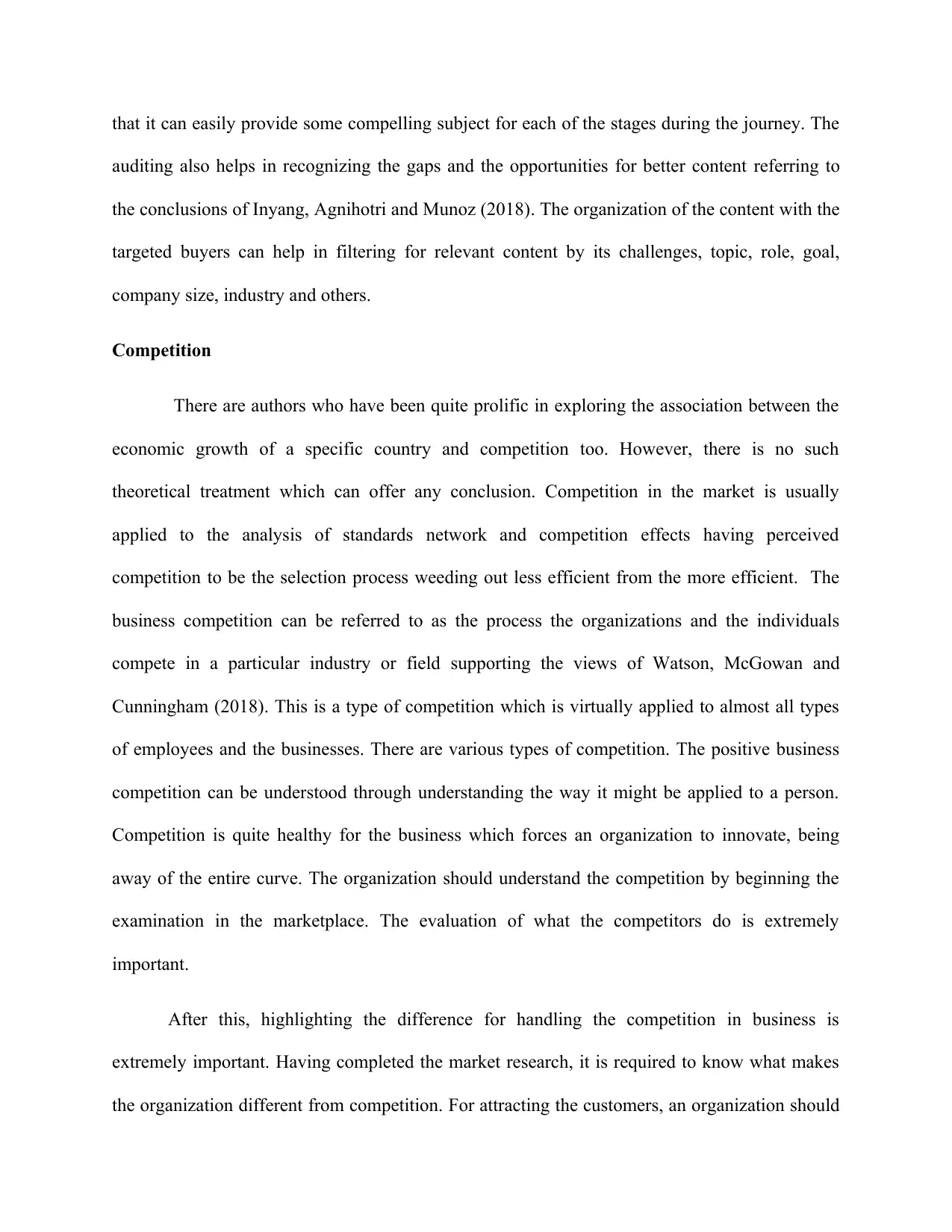
that it can easily provide some compelling subject for each of the stages during the journey. The
auditing also helps in recognizing the gaps and the opportunities for better content referring to
the conclusions of Inyang, Agnihotri and Munoz (2018). The organization of the content with the
targeted buyers can help in filtering for relevant content by its challenges, topic, role, goal,
company size, industry and others.
Competition
There are authors who have been quite prolific in exploring the association between the
economic growth of a specific country and competition too. However, there is no such
theoretical treatment which can offer any conclusion. Competition in the market is usually
applied to the analysis of standards network and competition effects having perceived
competition to be the selection process weeding out less efficient from the more efficient. The
business competition can be referred to as the process the organizations and the individuals
compete in a particular industry or field supporting the views of Watson, McGowan and
Cunningham (2018). This is a type of competition which is virtually applied to almost all types
of employees and the businesses. There are various types of competition. The positive business
competition can be understood through understanding the way it might be applied to a person.
Competition is quite healthy for the business which forces an organization to innovate, being
away of the entire curve. The organization should understand the competition by beginning the
examination in the marketplace. The evaluation of what the competitors do is extremely
important.
After this, highlighting the difference for handling the competition in business is
extremely important. Having completed the market research, it is required to know what makes
the organization different from competition. For attracting the customers, an organization should
auditing also helps in recognizing the gaps and the opportunities for better content referring to
the conclusions of Inyang, Agnihotri and Munoz (2018). The organization of the content with the
targeted buyers can help in filtering for relevant content by its challenges, topic, role, goal,
company size, industry and others.
Competition
There are authors who have been quite prolific in exploring the association between the
economic growth of a specific country and competition too. However, there is no such
theoretical treatment which can offer any conclusion. Competition in the market is usually
applied to the analysis of standards network and competition effects having perceived
competition to be the selection process weeding out less efficient from the more efficient. The
business competition can be referred to as the process the organizations and the individuals
compete in a particular industry or field supporting the views of Watson, McGowan and
Cunningham (2018). This is a type of competition which is virtually applied to almost all types
of employees and the businesses. There are various types of competition. The positive business
competition can be understood through understanding the way it might be applied to a person.
Competition is quite healthy for the business which forces an organization to innovate, being
away of the entire curve. The organization should understand the competition by beginning the
examination in the marketplace. The evaluation of what the competitors do is extremely
important.
After this, highlighting the difference for handling the competition in business is
extremely important. Having completed the market research, it is required to know what makes
the organization different from competition. For attracting the customers, an organization should
Paraphrase This Document
Need a fresh take? Get an instant paraphrase of this document with our AI Paraphraser
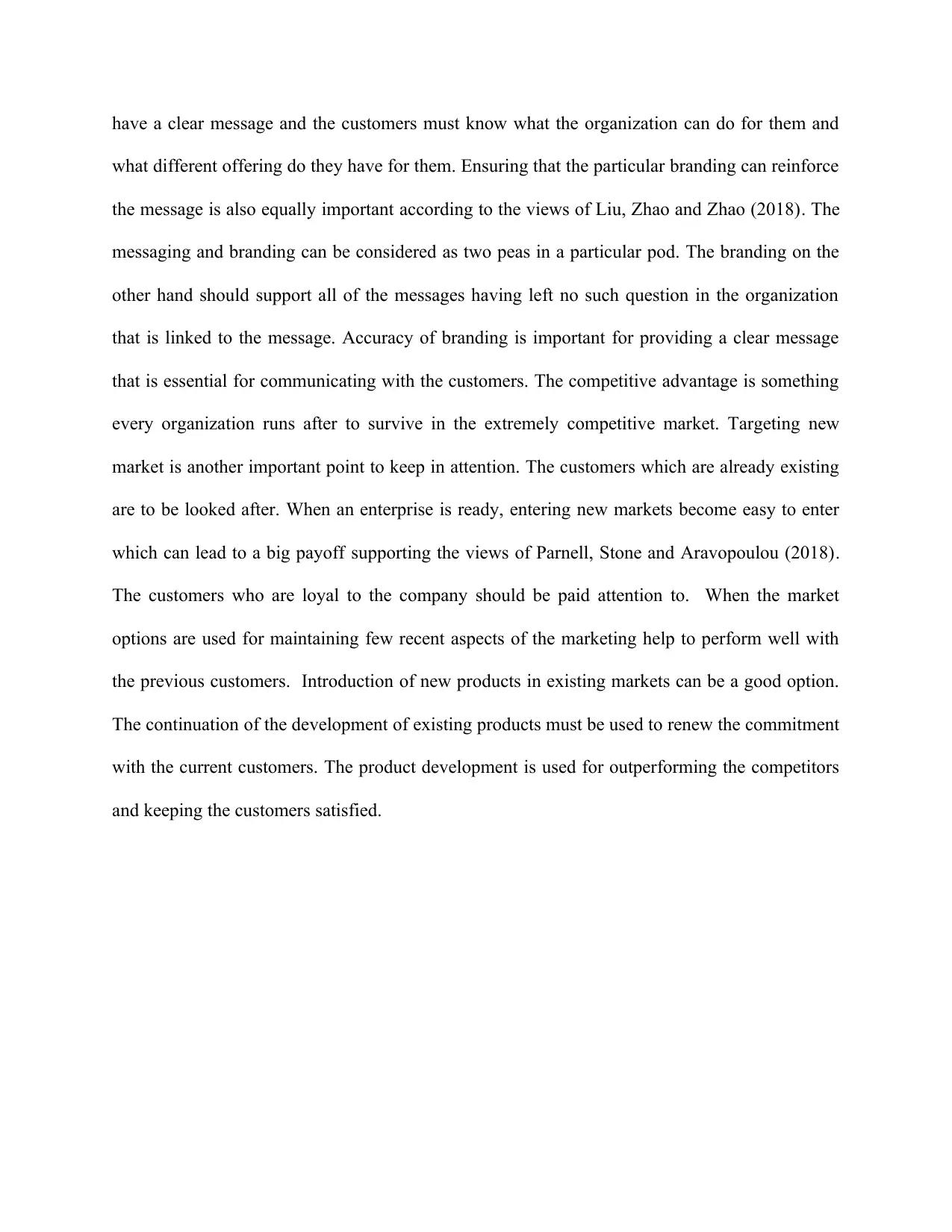
have a clear message and the customers must know what the organization can do for them and
what different offering do they have for them. Ensuring that the particular branding can reinforce
the message is also equally important according to the views of Liu, Zhao and Zhao (2018). The
messaging and branding can be considered as two peas in a particular pod. The branding on the
other hand should support all of the messages having left no such question in the organization
that is linked to the message. Accuracy of branding is important for providing a clear message
that is essential for communicating with the customers. The competitive advantage is something
every organization runs after to survive in the extremely competitive market. Targeting new
market is another important point to keep in attention. The customers which are already existing
are to be looked after. When an enterprise is ready, entering new markets become easy to enter
which can lead to a big payoff supporting the views of Parnell, Stone and Aravopoulou (2018).
The customers who are loyal to the company should be paid attention to. When the market
options are used for maintaining few recent aspects of the marketing help to perform well with
the previous customers. Introduction of new products in existing markets can be a good option.
The continuation of the development of existing products must be used to renew the commitment
with the current customers. The product development is used for outperforming the competitors
and keeping the customers satisfied.
what different offering do they have for them. Ensuring that the particular branding can reinforce
the message is also equally important according to the views of Liu, Zhao and Zhao (2018). The
messaging and branding can be considered as two peas in a particular pod. The branding on the
other hand should support all of the messages having left no such question in the organization
that is linked to the message. Accuracy of branding is important for providing a clear message
that is essential for communicating with the customers. The competitive advantage is something
every organization runs after to survive in the extremely competitive market. Targeting new
market is another important point to keep in attention. The customers which are already existing
are to be looked after. When an enterprise is ready, entering new markets become easy to enter
which can lead to a big payoff supporting the views of Parnell, Stone and Aravopoulou (2018).
The customers who are loyal to the company should be paid attention to. When the market
options are used for maintaining few recent aspects of the marketing help to perform well with
the previous customers. Introduction of new products in existing markets can be a good option.
The continuation of the development of existing products must be used to renew the commitment
with the current customers. The product development is used for outperforming the competitors
and keeping the customers satisfied.
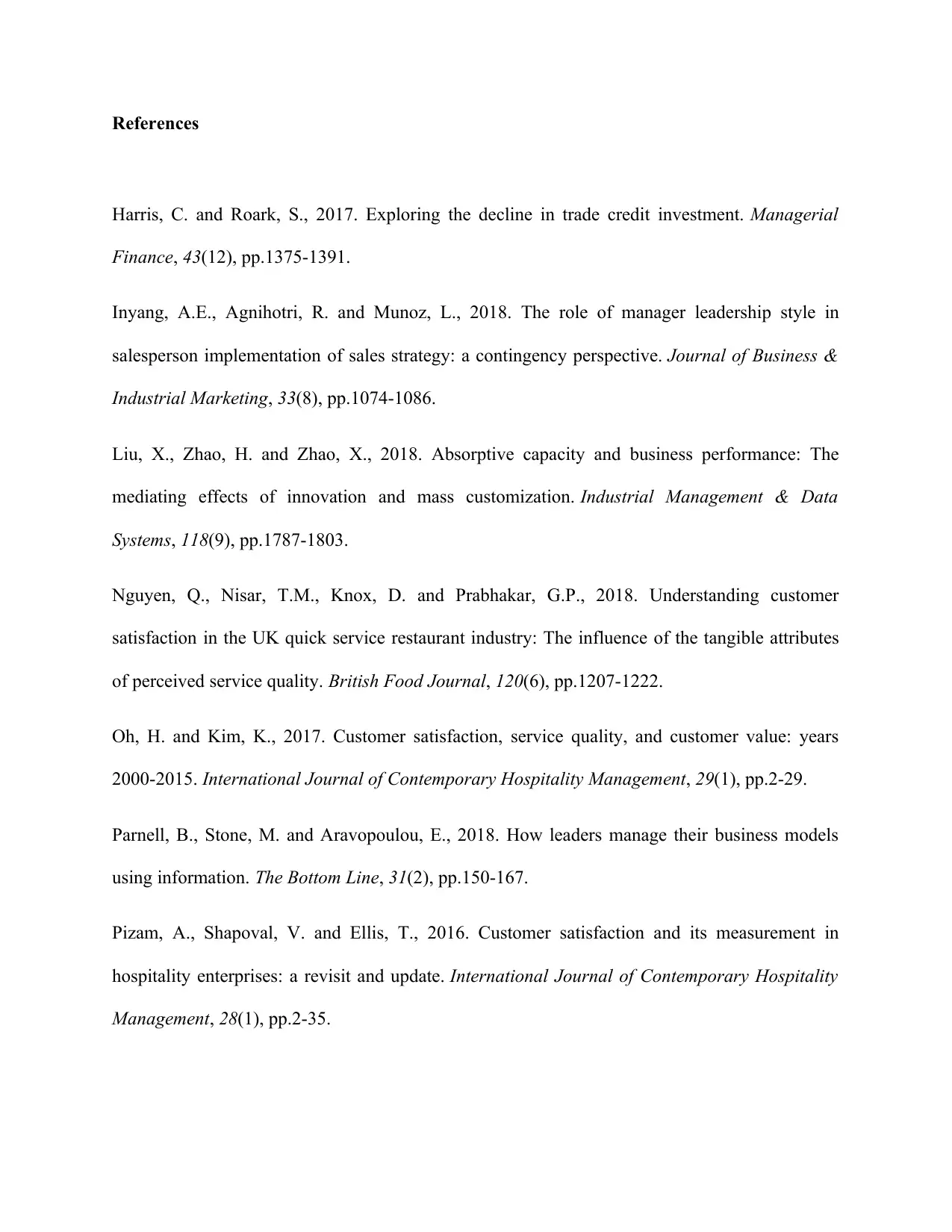
References
Harris, C. and Roark, S., 2017. Exploring the decline in trade credit investment. Managerial
Finance, 43(12), pp.1375-1391.
Inyang, A.E., Agnihotri, R. and Munoz, L., 2018. The role of manager leadership style in
salesperson implementation of sales strategy: a contingency perspective. Journal of Business &
Industrial Marketing, 33(8), pp.1074-1086.
Liu, X., Zhao, H. and Zhao, X., 2018. Absorptive capacity and business performance: The
mediating effects of innovation and mass customization. Industrial Management & Data
Systems, 118(9), pp.1787-1803.
Nguyen, Q., Nisar, T.M., Knox, D. and Prabhakar, G.P., 2018. Understanding customer
satisfaction in the UK quick service restaurant industry: The influence of the tangible attributes
of perceived service quality. British Food Journal, 120(6), pp.1207-1222.
Oh, H. and Kim, K., 2017. Customer satisfaction, service quality, and customer value: years
2000-2015. International Journal of Contemporary Hospitality Management, 29(1), pp.2-29.
Parnell, B., Stone, M. and Aravopoulou, E., 2018. How leaders manage their business models
using information. The Bottom Line, 31(2), pp.150-167.
Pizam, A., Shapoval, V. and Ellis, T., 2016. Customer satisfaction and its measurement in
hospitality enterprises: a revisit and update. International Journal of Contemporary Hospitality
Management, 28(1), pp.2-35.
Harris, C. and Roark, S., 2017. Exploring the decline in trade credit investment. Managerial
Finance, 43(12), pp.1375-1391.
Inyang, A.E., Agnihotri, R. and Munoz, L., 2018. The role of manager leadership style in
salesperson implementation of sales strategy: a contingency perspective. Journal of Business &
Industrial Marketing, 33(8), pp.1074-1086.
Liu, X., Zhao, H. and Zhao, X., 2018. Absorptive capacity and business performance: The
mediating effects of innovation and mass customization. Industrial Management & Data
Systems, 118(9), pp.1787-1803.
Nguyen, Q., Nisar, T.M., Knox, D. and Prabhakar, G.P., 2018. Understanding customer
satisfaction in the UK quick service restaurant industry: The influence of the tangible attributes
of perceived service quality. British Food Journal, 120(6), pp.1207-1222.
Oh, H. and Kim, K., 2017. Customer satisfaction, service quality, and customer value: years
2000-2015. International Journal of Contemporary Hospitality Management, 29(1), pp.2-29.
Parnell, B., Stone, M. and Aravopoulou, E., 2018. How leaders manage their business models
using information. The Bottom Line, 31(2), pp.150-167.
Pizam, A., Shapoval, V. and Ellis, T., 2016. Customer satisfaction and its measurement in
hospitality enterprises: a revisit and update. International Journal of Contemporary Hospitality
Management, 28(1), pp.2-35.
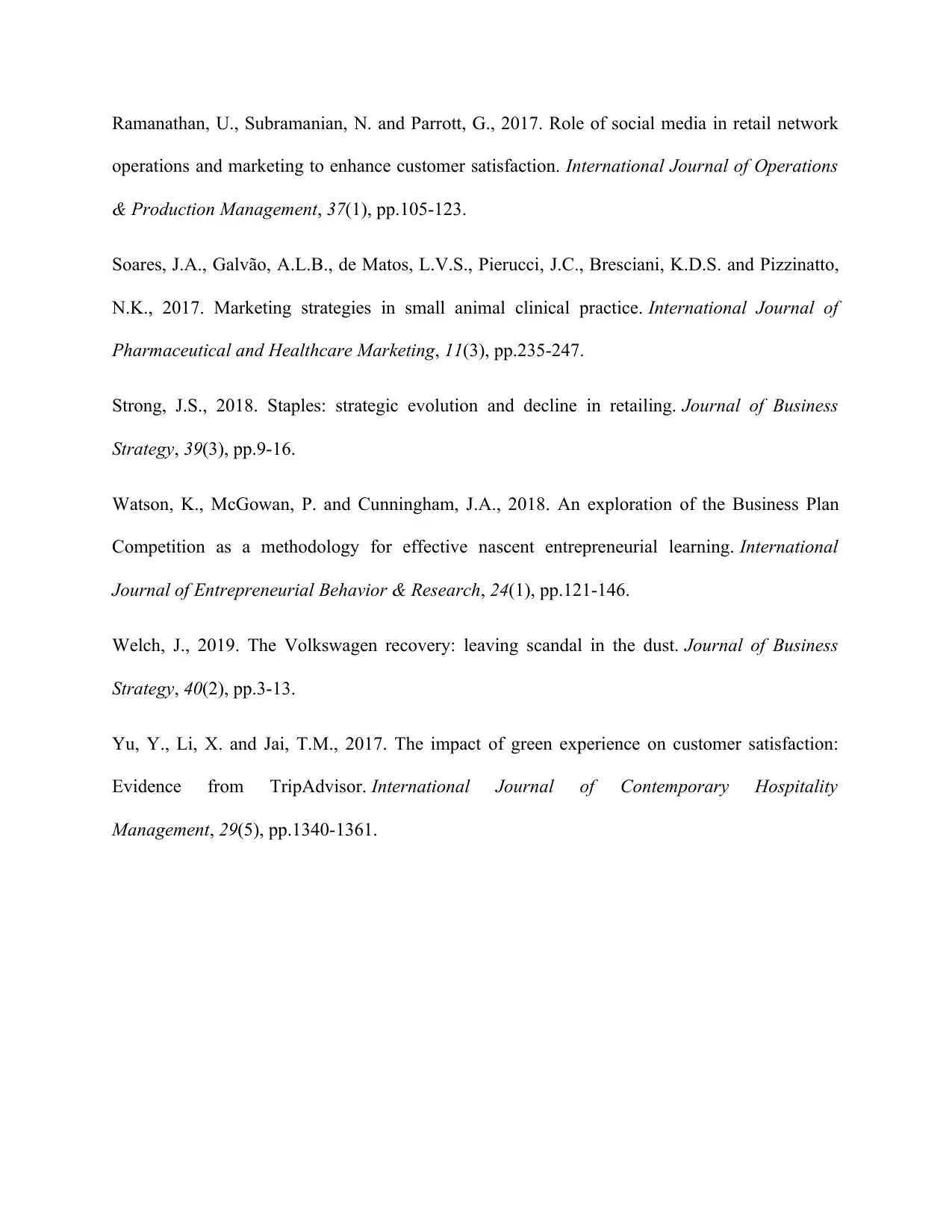
Ramanathan, U., Subramanian, N. and Parrott, G., 2017. Role of social media in retail network
operations and marketing to enhance customer satisfaction. International Journal of Operations
& Production Management, 37(1), pp.105-123.
Soares, J.A., Galvão, A.L.B., de Matos, L.V.S., Pierucci, J.C., Bresciani, K.D.S. and Pizzinatto,
N.K., 2017. Marketing strategies in small animal clinical practice. International Journal of
Pharmaceutical and Healthcare Marketing, 11(3), pp.235-247.
Strong, J.S., 2018. Staples: strategic evolution and decline in retailing. Journal of Business
Strategy, 39(3), pp.9-16.
Watson, K., McGowan, P. and Cunningham, J.A., 2018. An exploration of the Business Plan
Competition as a methodology for effective nascent entrepreneurial learning. International
Journal of Entrepreneurial Behavior & Research, 24(1), pp.121-146.
Welch, J., 2019. The Volkswagen recovery: leaving scandal in the dust. Journal of Business
Strategy, 40(2), pp.3-13.
Yu, Y., Li, X. and Jai, T.M., 2017. The impact of green experience on customer satisfaction:
Evidence from TripAdvisor. International Journal of Contemporary Hospitality
Management, 29(5), pp.1340-1361.
operations and marketing to enhance customer satisfaction. International Journal of Operations
& Production Management, 37(1), pp.105-123.
Soares, J.A., Galvão, A.L.B., de Matos, L.V.S., Pierucci, J.C., Bresciani, K.D.S. and Pizzinatto,
N.K., 2017. Marketing strategies in small animal clinical practice. International Journal of
Pharmaceutical and Healthcare Marketing, 11(3), pp.235-247.
Strong, J.S., 2018. Staples: strategic evolution and decline in retailing. Journal of Business
Strategy, 39(3), pp.9-16.
Watson, K., McGowan, P. and Cunningham, J.A., 2018. An exploration of the Business Plan
Competition as a methodology for effective nascent entrepreneurial learning. International
Journal of Entrepreneurial Behavior & Research, 24(1), pp.121-146.
Welch, J., 2019. The Volkswagen recovery: leaving scandal in the dust. Journal of Business
Strategy, 40(2), pp.3-13.
Yu, Y., Li, X. and Jai, T.M., 2017. The impact of green experience on customer satisfaction:
Evidence from TripAdvisor. International Journal of Contemporary Hospitality
Management, 29(5), pp.1340-1361.
1 out of 10
Related Documents
Your All-in-One AI-Powered Toolkit for Academic Success.
+13062052269
info@desklib.com
Available 24*7 on WhatsApp / Email
![[object Object]](/_next/static/media/star-bottom.7253800d.svg)
Unlock your academic potential
© 2024 | Zucol Services PVT LTD | All rights reserved.





